Mayor Barrett’s 2015 State of the City Address
Monday, March 9th, 2015 - Alverno College
Good morning. Thank you, Kadijiha! You are an impressive young woman with great promise.
Thank you also Dr. Meehan for hosting us and more importantly for leading a college we are proud calls Milwaukee home. Alverno’s reputation for excellence is recognized far and wide and your unique curriculum positions students for success.
Milwaukee needs more Alverno graduates. More future leaders like Kadijiha, who are learning skills for a career and important life lessons too.
We are One Milwaukee, a City with solid, shared values. We embrace hard work, honesty, ambition, and cooperation. We seek the best for our children; we want opportunity for ourselves and our neighbors; we appreciate Milwaukee’s natural beauty and quality of life.
Milwaukee in 2015 is a city where opportunity is growing, investments are increasing and residents are tackling new endeavors. Milwaukee is strong, and this is a year to build on our strengths.
I know we have real challenges. In certain neighborhoods, crime and housing are significant concerns. Education and public health require our constant attention.
Through all our opportunities and challenges, I continue to push city government to do more – to innovate and to improve. More importantly, I insist on partnerships. We achieve so much more when we collaborate and cooperate.
Alverno College embraces that approach. This is an academic institution renowned for connecting its students in a meaningful way to the outside world–building connections and partnerships. That serves its students well and benefits our entire city.
Kadijiah told you, she got her first job, her first meaningful job, through our Earn & Learn program. Everyone is this room remembers their first job; every one of us. I was a paperboy and an usher at the very first Milwaukee Brewers game. I was focused on a paycheck, but as we all know, a first job pays off in another way: it teaches responsibility. This happens when an employer offers a young person an opportunity.
That’s what we’re doing with the Earn & Learn program. We’re creating hope and opportunity in the lives of young people in Milwaukee. Since 2005, we’ve employed more than 22,000 teens and raised more than $4.5 million. The Earn & Learn program is your chance to join a great cause. We have young people who need your help.
Earn & Learn jobs don’t just put a few bucks in their pockets – they teach teens how to interact with people and the value of being involved in the workforce. There are many partners involved with Earn & Learn, and they are making a difference.
I need the employers in this room and throughout the City to join the Earn & Learn team. Please contact my office and let us know you want to be part of this effort.
The overall health of our City depends on the quality of life of each of its families has, and that starts with a job. That’s why we developed my Compete Milwaukee program. In partnership with Aldermen Ashanti Hamilton, Willie Wade, and Russell Stamper, we are building a solid foundation for employment opportunities. Our goal is to match workers with jobs, and employers with a strong workforce. In 2015, the City will have 135 transitional jobs.
For example, as part of Compete Milwaukee, Police Chief Edward Flynn and I started the Police Ambassador program. The Police Department created 17 part-time, year-long jobs for young adults. As part of their experience, each Ambassador will be paired with an officer mentor and will attend weekly educational sessions led by Police Academy staff. I would like to recognize Assistant Chief Edith Hudson, an Alverno College Alumna, whose leadership and hard work will make this new program a success. And as a special treat, today I am proud to introduce to you the first Milwaukee Police Ambassador class. They are here with Chief Flynn and their mentors. Please join me in welcoming them. Good luck!
Make no mistake about it, Milwaukeeans want to work. Last October, I co-hosted a job fair at Serb Hall where 2,000 people lined up for the chance to interview with 91 area companies.
Connecting workers and employers directly is key to putting people to work. That’s why I started the Mayor’s Manufacturing Partnership. In November, a dozen graduates of the partnership received job offers from one of the participating companies, Milwaukee Gear. Each graduate received training for an entry level position paying an average wage of $15 an hour.
Working with our partners, we can have an immediate and positive impact on the hiring of workers, by working closely with employers and designing job training specifically for their needs. From the start of the Manufacturing Partnership in 2012, we have worked with hundreds of employers and more than a thousand individuals have received employment offers. Potential workers and employers continue to tap into the Mayor’s Manufacturing Partnership.
To meet this demand, we have formed an Advisory Board chaired by David Mitchell of Monarch Corporation. Thank you, David, for leading this effort.
In recent months, I’ve toured a number of small Milwaukee manufacturers– companies like Church Metal Spinning, Pho-Tronics, and Maxon Industries. These companies, like dozens of other small manufacturers, employ local people and deliver their products around the country and around the world. They are continuing a Milwaukee manufacturing tradition – making products that are recognized for quality and value.
That tradition of excellence has been recognized by Chief Executive Magazine which recently listed Milwaukee as one of “5 Great Cities for Growing Your Manufacturing Business” saying: “The hard-working belt buckle of Wisconsin makes just about everybody’s list of rising manufacturing towns.” And I want that momentum to continue.
In addition to offering training, we’re working to make companies more energy efficient. Our ME3 sustainable manufacturing program works with small and medium- sized companies to reduce energy use and improve their competitiveness. Nine firms received assistance through ME3 last year including Klement’s Sausage and PAK Technologies. And our Me2 Residential and Commercial Programs have retrofitted over 1,200 homes and more than 130 businesses, stimulating nearly $20 million in economic activity in 2014.
Investment in our City is visible to anyone who visits. Cranes are perched over several city sites including the new 833 East Michigan building, riverfront housing at North End, and, most significantly, the new Northwestern Mutual tower. The benefits of constructing the Northwestern Mutual Tower are reverberating throughout the City. Northwestern Mutual uses twenty different Milwaukee-based certified small businesses, and I’m proud to say, the company is on track to meet its employment goals for city residents. That’s great.
Today, I’m pleased to announce a major contractor on the Northwestern Mutual building, Benson Industries, has agreed to lease space at Century City on the City’s north side. Benson is working on the curtain wall of the tower, and it will have more than forty employees in the building right at the corner of 27th and Townsend Streets.
We are working with our partners at Milwaukee 7 to attract new companies to the city. We are committed to working with existing companies to facilitate their growth. And, to encourage entrepreneurs, we are working with organizations including Scale-up, Kiva, Gener8tor, Biz Starts and the Wisconsin Women’s Business Initiative. We’re doing that because Milwaukee is a great place to start and grow a business.
Milwaukee is also a great place for an NBA team – our Milwaukee Bucks. We’re also a great City for major entertainment, conventions, college basketball and we are primed for more significant investment. I support the Governor’s arena financing plan. I have had productive conversations with legislative leaders and the Bucks ownership group. We can come to an agreement – an agreement that will not include raising property taxes – to finance a new arena and spur economic development. I’m confident we will get this done.
A recent report published by City Observatory supports what I’ve been saying for months: We have momentum in this city, and we want to continue that momentum. The report showed city centers have been experiencing stronger job growth than their surrounding suburbs and Milwaukee is one of the leaders. Something significant is going on both in terms of investment and population growth right in the heart of our city.
And yet, at the very time we are making significant gains, the University of Wisconsin Milwaukee is facing a two-year $40 million state budget cut. That’s the largest state budget cut in UWM’s history. People don’t realize it, but there are 2,000 UWM alumni working at Northwestern Mutual, Rockwell and Johnson Controls alone. Over 70% of UWM’s graduates remain in Wisconsin. Talk about helping to plug the brain drain.
From nursing, to the arts, to the only school of architecture in the state, UWM produces talent for Milwaukee. I fought hard for the UWM Zilber School of Public Health and the School of Freshwater Science because both schools attract talent and research dollars to Milwaukee and are key components in our revitalization efforts. Let’s not regress.
Now you may have heard, the City of Milwaukee just moved forward with a significant, some would even say slightly controversial, public works project. You know where I’m going; I’m speaking, of course, of the streetcar.
Throughout the debate, my position has remained the same. I want to build on the momentum we’ve had and continue to create jobs and spur economic development. And a healthy downtown benefits the entire city.
There are so many partners who have gotten us to this point. Ultimately, the Common Council voted to move this project forward. Thank you to them for understanding the value of the streetcar to Milwaukee. I know the members of the Common Council share my commitment to expansion into our neighborhoods as well.
To the business leaders in this community, thank you for recognizing the importance of modern transportation in attracting and retaining talent. Thank you to the business improvement districts who fight to improve property values and spur economic development. Thank you to organized labor, who knows this project will bring both construction and long-term employment.
Thank you to the cultural attractions who know that good mass transit draws visitors from both near and far. And finally, thank you to the many civic boosters who work every day to make sure Milwaukee is a world-class city.
The Streetcar is a part of my vision for a comprehensive transportation strategy that also includes cars, buses, bikes and pedestrians. Key to that plan is our streets.
We have made significant improvements in the quality of our streets. During my time as Mayor, the street replacement cycle has gone from 108 years to 62 years. But there’s more to be done. We know well because it’s pothole season. This year, we’re more than doubling the resources devoted to what I like to call Extreme Makeover Milwaukee Edition. So here’s how it works: in one day, our High Impact Paving Program comes in and completely re-paves a street. Through this process, we will repave 21 miles of city streets this year.
The City of Milwaukee continues to grow as a bicycle-friendly community. In 2015, we will add 10 more miles of designated bike lanes and, in partnership with Midwest Bike Share, add at least 30 more Bublr Bike Stations.
And while we’re on the topic of bubblers, the City’s water utility is significantly increasing its water main work, replacing 101 miles of mains over the next six years. We are doing that because I know Infrastructure is important.
My Strong Neighborhoods Plan defines strategies for revitalization throughout our neighborhoods; and, as blight is eliminated, vacant spaces are re-activated and housing stock is restored.
I have committed more than twenty million dollars to build stronger and safer neighborhoods.
Our gains don’t diminish the magnitude of the foreclosure crisis. But we’ve made significant progress and exceeded many of our initial goals. Initially, we wanted to sell 350 properties: we actually sold 437, adding almost $19 million to the tax rolls. We wanted to sell or improve 100 vacant lots: well, we did 225. We made huge strides to clear dangerous and unstable properties from our neighborhoods by demolishing more than 400 abandoned buildings.
Through our Home Buying Assistance program, people like Mark Schneider, a first-time homebuyer, purchased a city-owned property on West Nash Street. This home and others sold by the City last year have gone from vacant to valued, thanks to the hard work of our dedicated team. But we’re not letting up.
We’re taking a hard line on “zombie” foreclosures, nuisance properties, and scofflaw owners. Common Council President Michael Murphy and I know that these issues are among the greatest challenges facing our city’s neighborhoods.
Since the early days of the foreclosure crisis, we have had some great banking partners in the City. PyraMax Bank, Northshore Bank, and US Bank have worked with us on foreclosure issues, including being lenders for our Homebuyer Assistance Program. This year, we’re happy to add Anchor Bank as a lending partner.
We are pushing back on this problem together, and will continue turning neighborhood eyesores into neighborhood assets. Last year, we converted 70 City lots into urban orchards and gardens. Working with neighbors and community partners, we made City-funded improvements on 54 lots. We sold nearly one hundred lots to adjacent neighbors who agreed to maintain them. This year, we will sell at least another 100 lots, improve 80, and continue to be a national leader in transforming vacant spaces.
The Greater Milwaukee Foundation recently received a $75,000 Bloomberg Award which will allow for the improvement of more than 50 vacant lots into urban orchards and pocket parks.
Our Home Gr/Own initiative will partner with the Foundation, the Northwestern Mutual Foundation, the Fund for Lake Michigan, and the Zilber Family Foundation to ensure that our urban agricultural efforts will – literally – bear more fruit.
The Bloomberg grant is being matched by our philanthropic partners and we’re receiving additional support from Growing Power and David Frank Landscape.
I want to take just a minute to talk about the pocket park we created at 14th and Wright in honor of Ezekiel Gillespie, the African-American voting rights leader. This is very timely. Built on a site that once had a foreclosed home and three vacant lots, the park now features a rain garden, fruit trees and berry bushes.
As you know, this past weekend, we commemorated the 50th anniversary of the March over the Edmund Pettus Bridge in Selma Alabama. The events of that day, “Bloody Sunday”, horrified the nation and propelled the introduction and passage of the 1965 Voting Rights Act.100 years before that, in 1865, Ezekiel Gillespie, a former slave, went to a Milwaukee voter registration station to register as a legal, Wisconsin voter. He was denied. Ezekiel took the fight to the Wisconsin Supreme court and in March, 1866, the court issued a unanimous decision in his favor.
The fight for voting rights has had a long, intense history. 150 years after Ezekiel Gillespie was denied the right to register to vote in Milwaukee, we are unfortunately, once again facing measures making it more difficult for people to cast a ballot. And, once again, we need to stand up for democracy.
We are fortunate to have so many dedicated partners who believe in Milwaukee and in building strong, safe and healthy neighborhoods.
Let me take you on a little tour, so you can see what’s going on in our neighborhoods. One of these partners is Journey House. Last October, we sold Journey House a foreclosed six-unit property on S. 23rd Street. After rehabilitation, the building will provide housing for youth who are aging out of foster care. Journey House will invest more than $140,000 to make repairs. Funding for the renovation is being provided through a loan and grant from Milwaukee County. Thank you County Executive Chris Abele and the Milwaukee County Board for that.
In January, I helped Sharon and Larry Adams of Walnut Way break ground on the Innovation and Wellness Commons at 16th and North. The first phase of the project will include the Milwaukee Center for Independence, a community business cooperative and a branch of Outpost Natural Foods.
Just up the street on 24th and North, I joined Sister Edna for the groundbreaking of the St. Ann Center for Intergenerational Care. This Center will provide community-based care for children, the elderly and people with disabilities. Thank you, Sister.
Residents in the Pulaski Park neighborhood, right here on the south side, are working with community stakeholders to reconnect the Kinnickinnic River corridor to the neighborhood. Their plan includes improvements to the park and investments in green infrastructure.
In the Amani Neighborhood, Tom Schneider, Executive Director of the Children’s Outing Association, joined forces with the Dominican Center, Children’s Hospital, and Marquette’s College of Nursing. Their collective goal there is to add strength and health to the United Amani Neighborhood and one measure of success: crime is down in that neighborhood.
In 2014, three Milwaukee community groups and the Milwaukee Police Department received national attention for their partnership to reduce crime. This was the first time since the MetLife Foundation and LISC initiated the Police-Community Partnership awards back in 2002 that three groups from the same city all won. Riverworks Development Corporation, the Holton Youth and Family Center, and the United Methodist Children’s Service-Washington Park Partners were all selected winners from more than 500 nationwide applicants. Congratulations and thank you for that.
Building on the strengths of our west side neighborhoods, Keith Stanley, Executive Director of the Avenues West Association, has teamed up with Harley-Davidson, MillerCoors, Aurora Health Care, the Potawatomi, and Marquette University to form the Near West Side Partners.
In June, Alderman Jose Perez and I attended the ribbon cutting for Pete’s Community Farm – now home to more than 25 varieties of produce and fruit trees. Thank you to our friends from Pete’s Market!
And just north of Alverno, the Jackson Park Community Association will launch the first Jackson Park Farmer’s Market this June.
Having a great city means that all residents, regardless of where they live or what their income is, can be healthy throughout their lives. This starts with my work on infant mortality, and ensuring that Milwaukee babies are born strong babies. Infant mortality is a complex problem that demands a sustained, communitywide effort.
I’m very grateful to have the faith-based community, the United Way and Columbia St. Mary’s to help in the fight. I am pleased to announce today that this year we are starting a year-round effort we’re calling the Strong Baby Sanctuary initiative. We will work with churches to make them safe places for pregnant women, new mothers, dads and families to get health-related support. We’re gathering faith-based leaders to recruit churches for this program. Reverend Dr. Garry Levy, the president of the General Baptist State Convention, will bring 30 church leaders to the initial launch event later this month so they can learn how they can support strong babies!
Bill Solberg from Columbia St. Mary’s and Courtney Rogaczewski of the March of Dimes are also here. Thank you all for your help.
Our work on infant mortality also includes investing resources in helping men become better fathers. As we approach the 10th anniversary of the Milwaukee Fatherhood Initiative, let’s celebrate dads. I’d like to acknowledge a special dad today, Lewis Lee. Lewis is not only a more motivated dad thanks to The Fatherhood Initiative, his positive experience led him to volunteer to help other fathers and families.
Just days ago, Lewis was accepted into the transitional jobs program and will be working at the Fatherhood Initiative full-time. I think Lewis is here with his children. There he is. Thank you Lewis.
We owe the children of Milwaukee and their families our very best work. That’s why the health department and the police department are working together with Milwaukee County to address childhood trauma. This partnership of mental health and law enforcement professionals will provide trauma informed responses to those exposed to violence. Thank you Alderwoman Milele Coggs for championing this important initiative.
Unfortunately, too much of the trauma we address results from gun violence. Guns in the hands of criminals produce far too much devastation in some of our neighborhoods. In 2014 we had a 14% reduction in homicides, but a 10 % increase in non-fatal shootings. I will never accept the silent premise that gun violence in Milwaukee is inevitable.
We must and will take assertive action. Our criminal justice system must work seamlessly and effectively to make Milwaukee safer. Last year, our police took more than 2,000 guns off our streets. We continue to invest in personnel and technology aimed at reducing gun violence, including a broad expansion of our ShotSpotter system. But, hundreds of guns used in Milwaukee crimes last year were purchased just months before the criminal act. These are not guns that were reported stolen, and they were purchased legally.
We must close loopholes and strengthen penalties to keep these weapons away from violent criminals. And Govenor Walker and state legislators must give the same attention to the lives of victims as they do to the NRA.
To further help build and strengthen neighborhoods, my plan is to have our entire neighborhood library system replaced or renovated by 2020. Under the leadership and watchful eye of Alderman Terry Witkowski, we will be reopening a fully-renovated Tippecanoe branch this year.
We also will begin construction of the new Forest Home branch, and with input from Alderman Bob Puente and the community, determine a final plan for the Mill Road library.
Our newest library—The East Branch—is attracting residents, and signing up new library card holders at a record pace. If you haven’t been there, I encourage you to visit. In fact, have Alderman Nik Kovac give you a tour. You will be wowed by the world-class community room, unique public art, the laptop bar, and an inviting living room with a fireplace. This is the type of innovation and quality design you can expect to see at all our neighborhood libraries.
Our libraries play a powerful role in life-long learning. There is an overwhelming amount of research which shows the most critical time to build brain connections is in the first three years of a child’s life. That’s why I’m proud to announce, the library, with funding from the Daniel M. Soref Charitable Trust, will provide comprehensive early literacy services.
Children from birth to age 5 in daycare centers will take part in an expanded ready-to-read program. The program will serve more than 32 childcare sites and more children in Milwaukee will enter school ready to read. That’s good news.
We’ll also continue our summer reading program serving more than 20,000 kids and, also during the school year we’ll help 10,000 students and parents achieve greater academic success with our teacher-in-the-library program.
With the opening of our first Express library, we became a national trendsetter. So what’s an Express Library? In partnership with the Housing Authority, we are among the first cities in the nation to install a 24-hour, automated library at Westlawn Gardens – think Red Box for books, but bigger and more attractive.
This is not the only innovation earning the Housing Authority recognition. The Housing Authority’s education initiative earned recognition from Harvard’s John F. Kennedy School as a winner in its 2015 Bright Ideas program. Darrell Finch, our Housing Authority Education specialist, works with hundreds of youth to ensure they attend school and achieve academic success. Since the Initiative was launched in 2005,142 high school seniors have participated and 91% of them have graduated. Congratulations Darrell and Housing Authority Executive Director Tony Perez.
I will continue to harness resources and build partnerships to improve the educational skills of all our children. These are efforts we should all be invested in. Unfortunately, our task will be made more difficult if the $12 million proposed state cut to Milwaukee Public Schools is approved. I ask all of you to do what you can to stop the cuts to k-12 education in Milwaukee.
We are blessed to have so many hard working, innovative and dedicated City workers. They are the people who plow our streets and pick up the garbage. They improve safety by enforcing the building code, answering 911 calls, and responding to emergencies. They plan the city’s future, meet with residents, and promote business activity. Too often, their work is unacknowledged, or worse, wrongly disparaged. I am grateful for city workers’ and their contributions that make Milwaukee a better city.
Let me tell you a story of the effectiveness and it involves the Fire Department and the amazing work they did last Nov. 14th.That evening, the WE Energies’ air sample collection team was about to call it a day and descend the 400 foot high Valley Power smokestack tower.
One by one, they were to use the one-person elevator that hugged the exterior of the chimney. Then the unthinkable happened – the elevator got stuck with the first worker inside, 170 feet from the ground. A weather front was moving in. Temperatures were now below freezing. Sustained winds were over 20 miles per hour, with frequent stronger gusts, causing a power cable to become entangled in the gears of the elevator.
When they arrived, the firefighters found they had one worker in an unheated elevator with no immediate means of escape. They had 4 workers 270 feet up, on a platform collar that encircled the smokestack. A total of 5 workers were trapped. This required Fire Department personnel to climb up to the workers. It took 11 fire and rescue companies over 6 hours to safely rescue the people stuck on the smokestack.
This was dangerous work and a moving example of the great work the men and women of our Fire Department do all the time. Please join me in recognizing and thanking Chief Mark Rohlfing and representatives from the Heavy Urban Rescue Team.
Fortunately, we have partners who share our goals. I want to give a special thanks to the Greater Milwaukee Foundation for helping us ensure all police officers receive critical incident training by the end of 2017.
Good policing, smart policing is at its very best when we thoughtfully review our practices. That’s why the Police Department has taken the lead in embracing and expanding its Crisis Intervention Team training which helps officers handle situations involving individuals in crisis. Thank you Ellen Gilligan of the Greater Milwaukee Foundation for your significant contribution. We appreciate it.
In closing, I want to thank you all for coming this morning. I’m grateful that when it comes to addressing issues in our community, we come together as partners. And what I see in all of you is an opportunity to do even more. You have creative energy and ideas and you have so much to contribute to Milwaukee, a stronger, one Milwaukee.
Thank you for everything you do for our great City, for making this one Milwaukee.
Past State of the City Addresses
Tom Barrett Photos
NOTE: This press release was submitted to Urban Milwaukee and was not written by an Urban Milwaukee writer. While it is believed to be reliable, Urban Milwaukee does not guarantee its accuracy or completeness.

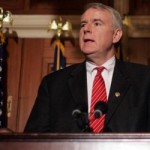
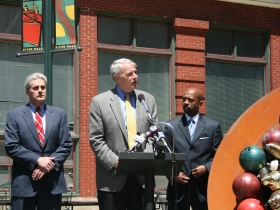
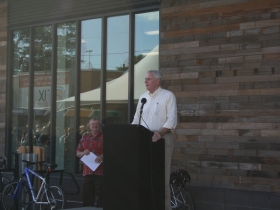
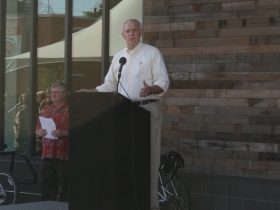
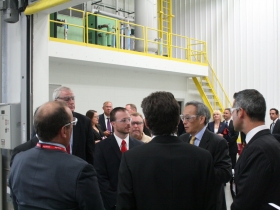
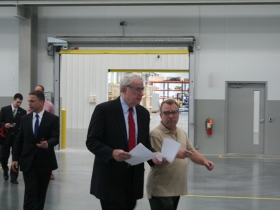
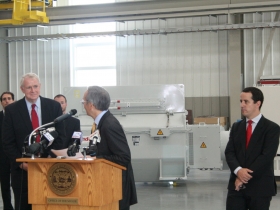
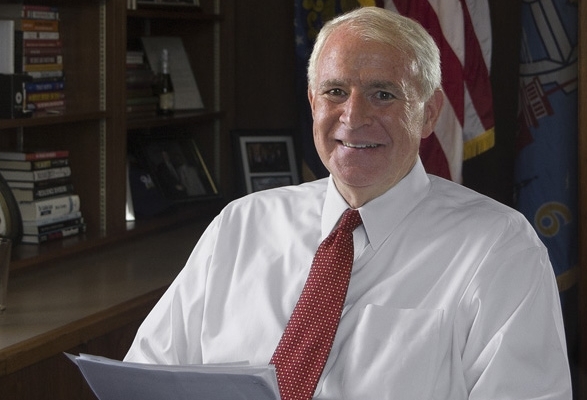




















Salute for the excellent developments supported with Mayor Barrett & the Milwaukee community.
Concordia University is exploring developing a business entrepreneurial center and supporting the community with entrepreneurship growth.
Perhaps the Mayor’s office would be able to offer ideas and connections for Concordia University to develop an exceptional business entrepreneurial center embracing the White House Building a Healthier America and teaming with the Medical College of Wisconsin building a Healthier Wisconsin with STEM pathways supporting the development of Wisconsin healthy lifestyles with initiatives of entrepreneurship, technology, designing healthy foods with k12 schools.
The Dean of Business for Concordia University welcomes vibrant ideas for supporting the advancement of the Milwaukee community with the future Concordia Entrepreneurial Business Center.